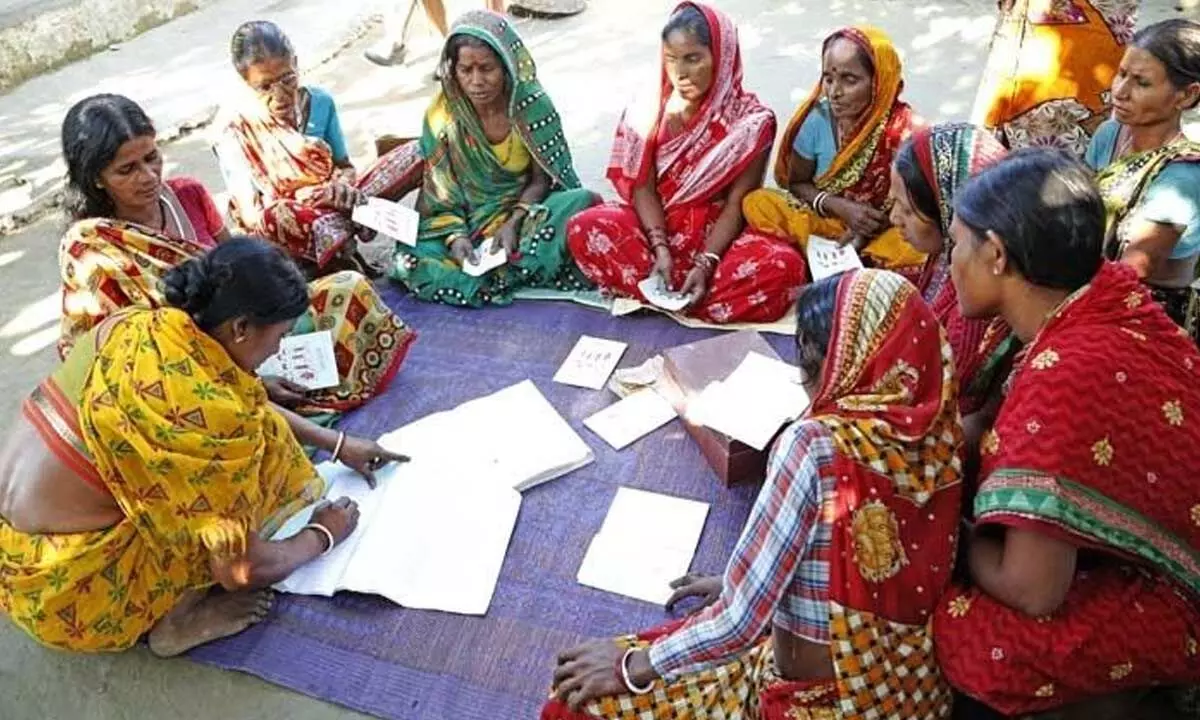Live
- India Faces Blow as Pacer Mohammed Shami Ruled Out for Remainder of Australia Series
- Farmer’s Day Celebrations Held at Palem Agricultural Research Center, Nagarkurnool
- Biden Pardon: Joe Biden Commutes Death Sentences of 37 Inmates, Including Child Killers and Mass Murderers
- South Korea: Yoon believes impeachment trial takes priority over martial law probe
- Strict Action for Non-Adherence to Time Management - DMHO Dr. Swarajya Lakshmi
- Joyful Semi-Christmas Celebrations at Sri Saraswathi International School
- Over 13.29 lakh houses approved for rural poor in Maharashtra: Shivraj Chouhan
- District Collector Urges Timely Completion of Indiramma Housing Scheme Survey
- Digital Arrest Scam: Hyderabad Man Duped of ₹7 Lakhs by Fake Crime Branch Police Callers
- Sukhbir Badal seeks President's Police medal for officer who saved his life
Just In
India’s SHGs emerging world’s biggest microfin project


Nine million SHGs in India; Almost 100 mn women as members
An SHG is usually a community of 10-12 women from a similar socio-economic background. These women form alliances to pool their financial resources for taking up joint economic activities, or to lend money at a reasonable interest rate to members for starting small businesses
“On this International Women’s Day (March 8), we are celebrating a unique story of success: that of women leaders from India’s powerful Self-Help Groups (SHGs). Theirs is a real story of hope and triumph. This is women’s power – unstoppable, and one that is driving development work across the country. These SHGs are becoming the new cooperatives for managing everything, from water supply and solid waste management to community kitchens and slum development,” said Sunita Narain, Director General, Centre for Science and Environment (CSE), speaking at a webinar here to mark the Day.
CSE organised the webinar against the backdrop of a cover story on SHGs done by Down To Earth, the magazine that it helps publish. Its panelists in the webinar included some of the women leaders and entrepreneurs who have been featured in the story – DrMeenu Singh, Director, AIIMS, Rishikesh; Heenaben Dave, Vice President, SEWA (Self-Employed Women’s Association), Ahmedabad; MeenaRahangdale, President, YogyataSwaSahayataSamuh, Balaghat (Madhya Pradesh); Mini Varghese, Mentor Resourceperson, Kudumbashree, Kerala; Padma Tashi, Production Manager, Looms of Ladakh Women’s Cooperative, Leh; and SabitaBehera, Jal Saathi, Puri (Odisha).
An SHG is usually a community of 10-12 women from a similar socio-economic background. These women form alliances to pool their financial resources for taking up joint economic activities, or to lend money at a reasonable interest rate to members for starting small businesses.
According to data released in December 2023 by the DeendayalAntyodayaYojana-National Rural Livelihoods Mission, India has nine million SHGs, with almost 100 million women as its members. With 0.65 million villages in the country (as per the 2011 Census), this amounts to 14 SHGs per village, with every eighth Indian woman being an SHG member.Down To Earth estimates that each SHG helps eight to 10 women start their own businesses.
SHGs trace their beginnings in India to the 1970s: a period when the most notable of them -- SEWA (Self-Employed Women’s Association) – took shape in Gujarat. In 1992, these groups were linked to banks under the SHG Bank Linkage Project (SHG-BLP). This was done to enable disbursal of small loans for setting up livelihood opportunities. These groups got a further boost in 1999 when the government decided to use them to promote self-employment in rural areas under its Swarn Jayanti Gram SwarojgarYojana.
In the years that followed, SHGs have increasingly become stronger, thanks to the government’s deliberate efforts to make them the executors of India’s key development agenda. In 2014, the government created a special fund (Community Investment Fund) that provides SHGs with up to Rs 50,000 a year to decide on and design local livelihood programmes.
Says Narain: “Today, India’s SHGs are collectively regarded as the world’s largest microfinance project. As per available official data, till February 2024, these groups disbursed loans amounting to Rs 1.7 lakh crore. Loans given by them rarely turn bad or require a waiver – the 2022-23 Economic Survey of India says SHGs’ bank repayment rate is over 96 per cent, underscoring their credit discipline and reliability.”
Says Down To Earth Managing Editor Richard Mahapatra: “In a male-dominated society, where women play significant but never-recognised roles, being a member of an SHG has become a badge of honour and an assertion of a new identity of power. SHGs offer outstanding examples of how such groups have managed and sustained development works that had seemed impossible to deliver.”
(https://www.cseindia.org/)

© 2024 Hyderabad Media House Limited/The Hans India. All rights reserved. Powered by hocalwire.com






